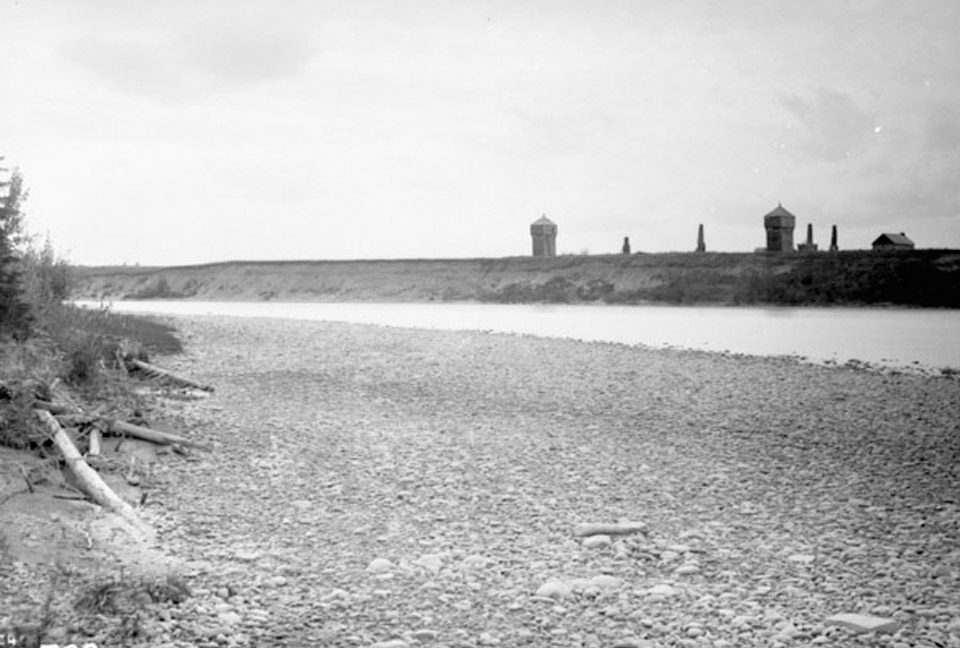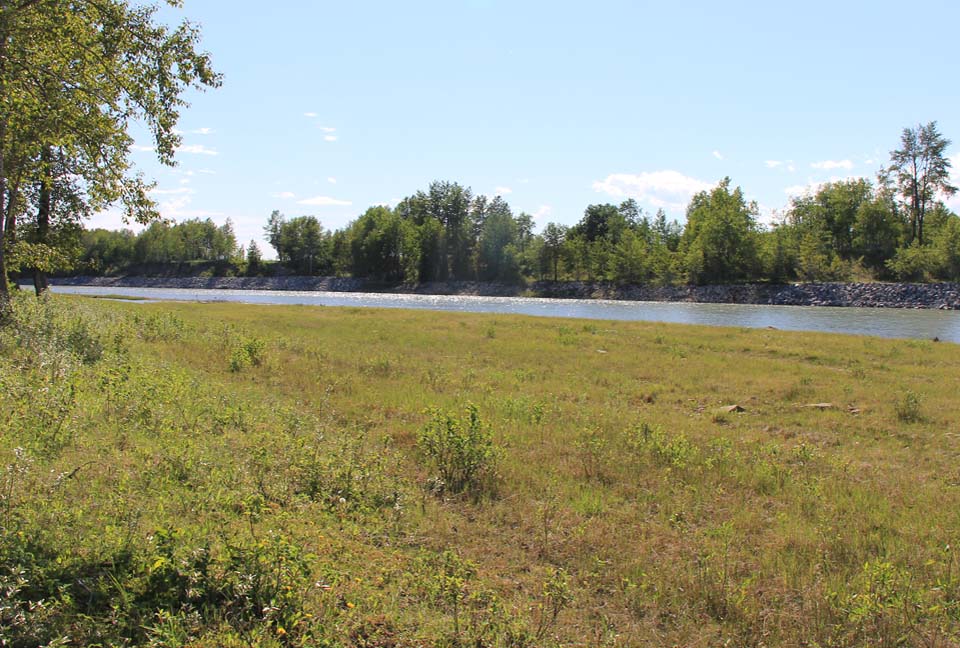The ruins of Rocky Mountain House on the North Saskatchewan River in 1886 (J.B. Tyrell, National Archives Canada-PA-038031) and in 2016 (CW-2016-06-04-0137). At the time of Tyrell’s photograph, only the bastions and chimneys of the trading post remained. The North Saskatchewan River is now regulated by the Bighorn Dam built about 100 km. upstream. The modified flow regime has reduced flood occurrence, allowing plants to colonize much of the river bed. Historically, frequent fires and firewood collecting removed trees higher on the banks. Today, forest groves of willow, poplar and trembling aspen obscure the view of Rocky Mountain House National Historic Site across the river.
Establishment of Trading Posts on the Upper North Saskatchewan
In the fall of 1800, David Thompson and his wife Charlotte reached Rocky Mountain House, recently constructed by the North West Company near the confluence of the North Saskatchewan and Clearwater rivers. Here, Thompson was to work under the direction of North West Company’s Duncan McGillivray who was “to be early at the Rocky Mountain House, about the latter end of September, 1800, to prepare for crossing the Mountains and proceeding to the Pacific Ocean for next year.” Unknown to the Nor’ Westers, due to other priorities, it would take Thompson more than a decade to complete his journey to the ocean. 1
Rocky Mountain House immediately had competition from the Hudson Bay Company traders who opened a post nearby. These posts had two main objectives. First, they could provide the Blackfoot confederacy tribes (Siksika, Piegan, and Kanai) from the south with trading posts separated from their traditional enemies (Cree and Assiniboine) that traded with forts further north. Secondly, the upper Saskatchewan location could be a jumping off location to cross the Rocky Mountains to contact people west of the Rockies.
North Wester Alexander Henry was stationed at Rocky Mountain House in the early years of the 1800’s, and noted:
“Our establishment stands on a high bank on the N. side of the river ; the situation is well adapted for defense, as the blockhouses command the fort for some distance. This spot was formerly covered with aspen and pine, which have been cut down for the use of the place, leaving a large open space. Frequent fires have aided much in clearing away the wood and brush, so that we now have a grand view of the Rocky mountains, lying nearly S. W., and apparently running from W. N. W. to S. S. E.” 2
After the amalgamation of the Hudson Bay and Northwest companies, Rocky Mountain House would remain an important trading location. Artist Paul Kane visited here in 1846, and described the animosities of the times between the native peoples in the area:
“I remained at Edmonton until the 12th of April, when, having beard that a large band of Blackfeet were shortly expected to visit Rocky Mountain House, situated about 180 miles south-west of Edmonton, on the Saskatchewan, for the purpose of trading, and being anxious to see them, I started with a small party of six men and about twenty horses, ten of which were loaded with goods…. We arrived at Rocky Mountain Fort on the 28th of April. This fort is beautifully situated on the banks of the Saskatchewan, in a small prairie, backed by the Rocky Mountains in the distance. In the vicinity was a camp of Assiniboine lodges, formed entirely of pine branches. It was built for the purpose of keeping a supply of goods to trade with the Blackfoot Indians, who come there every winter, and is abandoned and left empty every summer. It is built like most of the other forts, of wood, but with more than ordinary regard to strength, which is thought necessary on account of the vicious disposition of the Blackfoot tribe, who are, without exception, the most warlike on the continent…We found a man at the establishment, called Jemmy Jock, a Cree half-breed, who had temporary charge of it; he had obtained much Blackfoot celebrity. He was sent out when a clerk of Hudson’s Bay Company, by them, to the Blackfoot Indians, in order to learn their language, for the purpose of facilitating the trade with them. He then married a daughter of one of their chief, and taking a fancy to their mode of life, he left the Company’s service, and- stayed with them…Shortly after my arrival a report was brought in that the Blackfoot Indians had killed a party of Crees, and that amongst the slain was a pipe-stem carrier, whom they had skinned and stuffed with grass; the figure was then placed in a trail which the Crees were accustomed to pass in their hunting excursions. The Assiniboines, who reside in the vicinity of this fort, I found the most kind and honourable of any tribe that I met with.” 3
Over the years, as with most fur trade posts, Rocky Mountain House was moved, and rebuilt several times. The most recent, and elaborate version was built in 1868, and the remains of these building are shown in Tyrell’s photograph. The location is now a national historic park. The nearby town of Rocky Mountain House is a regional centre for current day the agriculture, forestry, and oil and gas industries. 4
Footnotes and Map
- Nesbit, J. The Mapmaker’s Eye: David Thompson on the Columbia Plateau. Pullman, WA: Washington State University Press. 2005, 25-26; Belyea, B., ed. Columbia Journals: David Thompson. Montreal and Kingston: McGill-Queen’s University Press, 1994, p. 181 ↩
- Coues, E., ed. The Manuscript Journals of Alexander Henry and David Thompson. New York: Harper, 1897. Vol 2: p. 701. ↩
- Kane, Paul. Wanderings of an Artist Among the Indians of North America and Canada From Vancouver’s Island and Oregon Through the Hudson’s Bay Company’s Territory and Back Again. London: Longman, Brown, Green, Longmans and Roberts, 1859, p. 408-409. ↩
- McDonald, P. Where the River Brought Them: 200 Years at Rocky Mountain House and Area. Rocky Mountain House, AB: Creative Office Design and Publishing, 2001. This publication provides an excellent history of the fort’s various locations, and the history of the town and region. ↩

